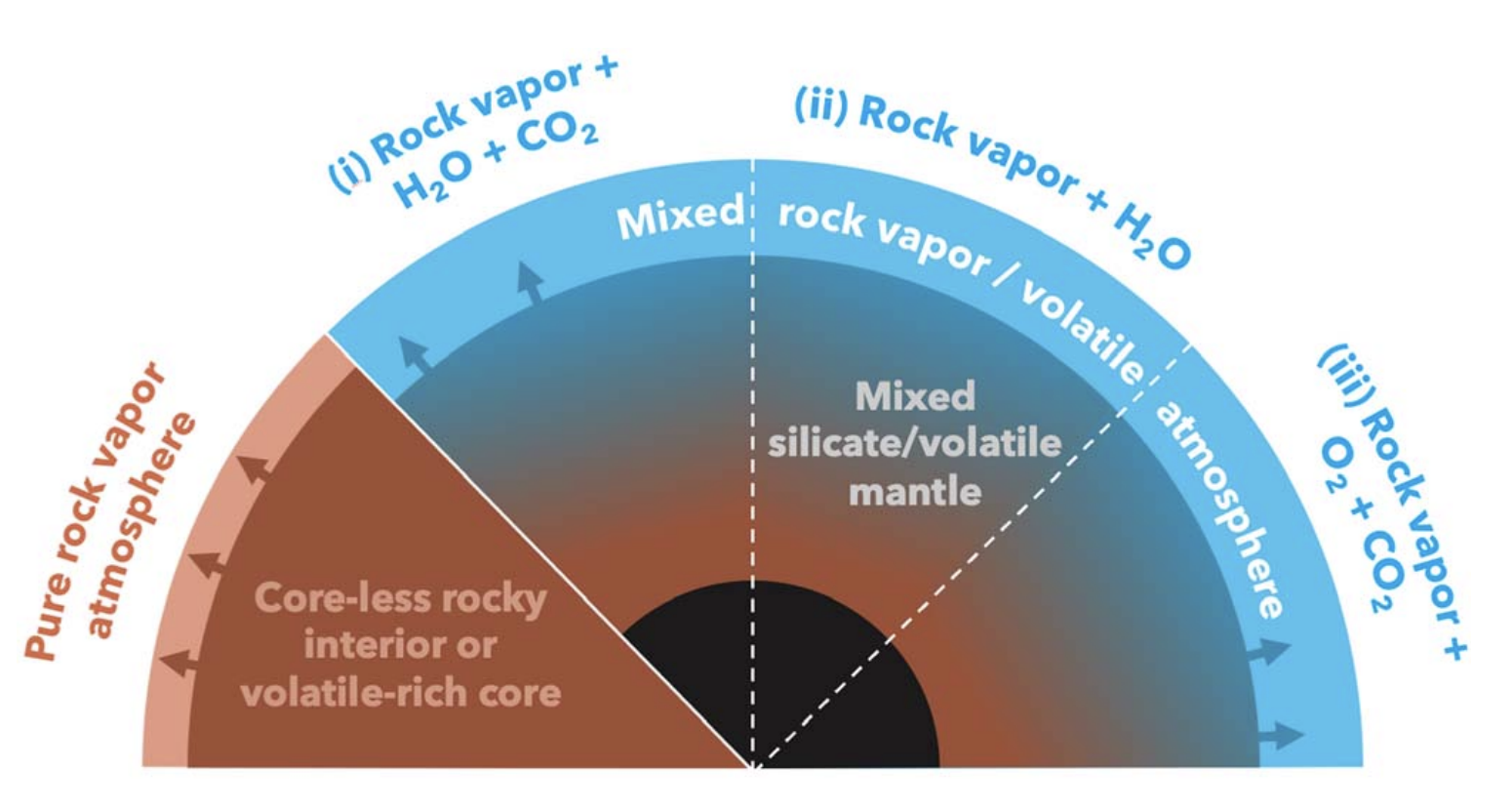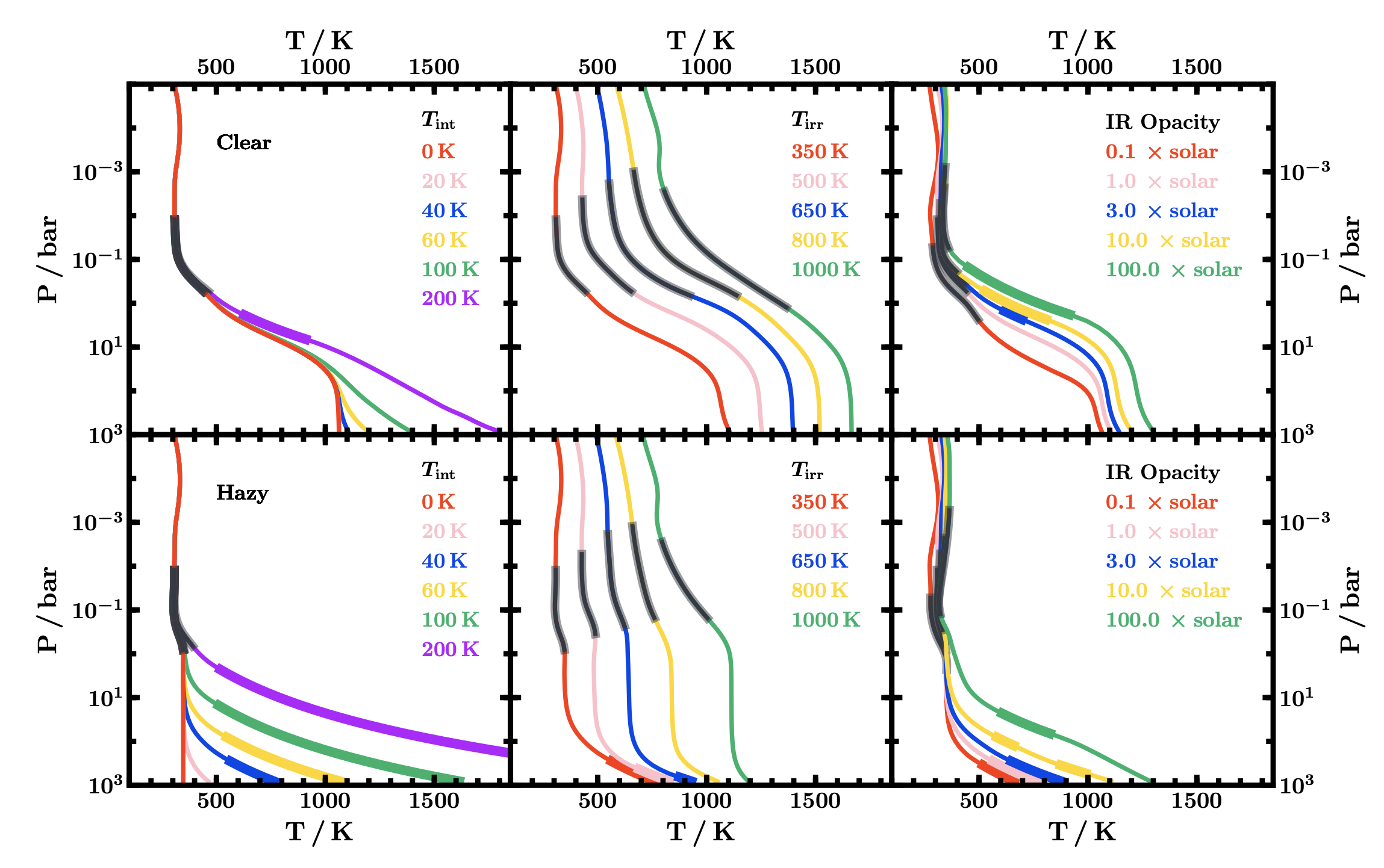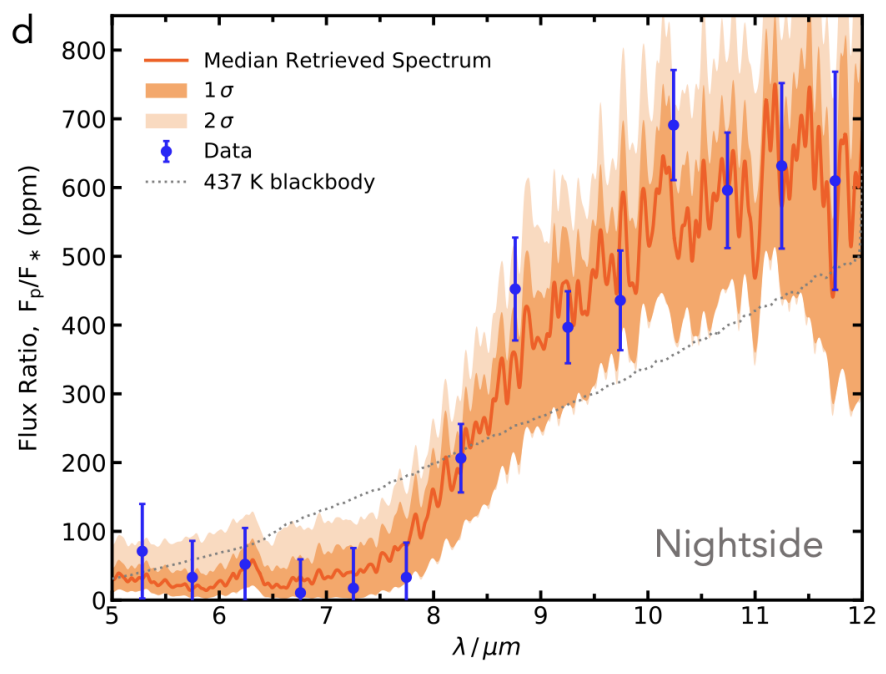Research
My research aims to uncover the diversity of planetary physics among the exoplanet population. The thousands of exoplanets known to date encompass a staggering range of temperatures, sizes and bulk densities, going beyond the conditions known to exist in the solar system. To learn about these distant planets, I use theoretical forward and inverse models of their atmospheres to study the interplay between various physical and chemical processes, and to place empirical constraints on these processes by interpreting atmospheric observations.
Below, you can read more about some of my recent projects. For a full list of publications, please see NASA ADS.
Rocky planet or water world? Observability of low-density lava world atmospheres
Super-Earths span a wide range of bulk densities, indicating a diversity in interior conditions beyond that seen in the solar system. In particular, an emerging population of low-density super-Earths may be explained by volatile-rich interiors. Among these, low-density lava worlds have dayside temperatures high enough to evaporate their surfaces, providing a unique opportunity to probe their interior compositions and test for the presence of volatiles. In this work, we investigate the atmospheric observability of low-density lava worlds.
Given the possibility of mixed volatile and silicate interior compositions for these planets, we consider a range of mixed volatile and rock vapour atmospheric compositions. We find that spectral features due to H2O, CO2, SiO and SiO2 are present in the infrared emission spectra as either emission or absorption features, depending on dayside temperature, volatile fraction and volatile composition. We further simulate JWST secondary eclipse observations for each of the three case studies, finding that H2O and/or CO2 could be detected with as few as ~5 eclipses. Detecting volatiles in these atmospheres would provide crucial independent evidence that volatile-rich interiors exist among the super-Earth population. Piette, A. A. A., Gao, P., Brugman, K., Shahar, A., Lichtenberg, T., Miozzi, F. & Driscoll, P. (2023), ApJ, 954, 29
Atmospheric retrieval of rocky exoplanets in thermal emission
Understanding the presence and nature of rocky exoplanet atmospheres is critical to understanding this diverse population of exoplanets and its potential for habitability. In particular, emission spectroscopy with JWST is a promising technique to determine the presence of and characterise atmospheres of rocky exoplanets, probing both their chemistry and thermal profiles.
Comprehensive retrieval approaches are required to interpret such observations within a robust statistical framework. In this work, we develop HyDRo: an atmospheric retrieval framework for thermal emission spectra of rocky exoplanets. HyDRo does not make prior assumptions about the background atmospheric composition, and can therefore be used to interpret spectra of secondary atmospheres with unknown compositions. We consider the observations required to characterise the atmospheres of three promising rocky exoplanets across the ~400-800K equilibrium temperature range: Trappist-1b, GJ 1132 b, and LHS 3844 b. HyDRo will allow important atmospheric constraints on rocky exoplanets with JWST observations, providing crucial insights into their geochemical environments.Piette, A. A. A., Madhusudhan, N., & Mandell, A. M. (2022), MNRAS, 511, 2565
Temperature profiles and emission spectra of mini-Neptune atmospheres
With their relatively large scale heights and large planet-star contrasts, mini-Neptunes are currently ideal targets towards the goal of characterising temperate low-mass exoplanets. Indeed, atmospheric observations of mini-Neptunes orbiting M-dwarfs are beginning to provide constraints on their chemical and thermal properties, while also providing clues about their interiors and potential surfaces.
In this work, we explore various aspects of mini-Neptunes, including radiative/convective energy transport, boundary conditions for the interior, and their potential habitability. We use self-consistent atmospheric models to investigate the effects of irradiation, internal flux, metallicity, clouds and hazes on the temperature profiles and thermal emission spectra of temperate mini-Neptune atmospheres. We find a range of physically-motivated atmospheric conditions that allow for liquid water under the H2-rich atmospheres of planets such as K2-18 b, and find that observations of thermal emission with JWST/MIRI spectrophotometry can place useful constraints on the habitability of such planets. Our results underpin the potential of temperate mini-Neptunes such as K2-18 b as promising candidates in the search for habitable exoplanets. Piette, A. A. A. & Madhusudhan, N. (2020), ApJ, 904, 154
A reflective, metal-rich atmosphere for the mini-Neptune GJ 1214 b
The most common type of exoplanet detected to date lies between the sizes of Earth and Neptune. The size distribution of these 'sub-Neptunes' is bifurcated, and the larger sub-population (mini-Neptunes) are thought to host hydrogen-rich atmospheres. GJ 1214 b is an archetypal mini-Neptune, but previous observations of its atmosphere have been featureless due to the presence of high-altitude aerosols.
In order to learn more about this enigmatic planet, our team observed a full-orbit phase curve of GJ 1214 b using JWST's MIRI LRS instrument (5-12 microns). The dayside and nightside emission spectra show absorption features, allowing us to probe the composition of this atmosphere for the first time. Using atmospheric retrievals, including the HyDRo framework (described above), we find that this absorption is most likely due to H2O. Comparisons of the phase curve to 3D atmospheric models indicate that GJ 1214 b's atmosphere is rich in heavy elements and hosts highly reflective hazes. The MIRI LRS transmission spectrum further constrains the metallicity to be ≥ 1000x solar, with a highly efficient haze production rate. Kempton, E. M.-R., Zhang, M., Bean, J. L., Steinrueck, M. E., Piette, A. A. A. et al. (2023), Nature, 620, 67 ; Gao, P., Piette, A. A. A., Steinrueck, M. E., Nixon, M., Zhang, M. et al. (2023), ApJ, 951, 96
Assessing spectra and thermal inversions due to TiO in hot Jupiter atmospheres
Thermal inversions have been detected in several hot Jupiter atmospheres, motivating new avenues to understand the many factors affecting their temperature structures. TiO has long been proposed to cause such thermal inversions, and has been detected in the optical and near-infrared. As such detections rely on the accuracy of the TiO cross-sections used, the recently reported TOTO TiO line list provides a new opportunity to investigate these dependences.
In this work, we find that the improvement in the TOTO line list compared to a previous line list results in observable differences in the spectra of hot Jupiters, particularly in the optical at high resolution. We also explore the interplay between temperature structure, irradiation, and composition with TiO as the primary source of optical opacity, using 1D self-consistent atmospheric models. Among other trends, we find that the propensity for thermal inversions due to TiO peaks at C/O ∼ 0.9, consistent with recent studies. Using these models, we further assess metrics to quantify thermal inversions due to TiO, compared to frequently used Spitzer photometry, over a range in C/O, irradiation, metallicity, gravity, and stellar type. Piette, A. A. A., Madhusudhan, N., McKemmish, L. K., Gandhi, S., Masseron, T., Welbanks, L. (2020), MNRAS, 496, 3870
Considerations for atmospheric retrieval of high-precision brown-dwarf spectra
Isolated brown dwarfs provide remarkable laboratories for understanding atmospheric physics in the low-irradiation regime, and can be observed more precisely than exoplanets. As such, they can provide a glimpse into the future of high-SNR observations of exoplanets.
In this work, we investigate several new considerations that are important for atmospheric retrievals of high-quality thermal emission spectra of sub-stellar objects. We propose a new parametric pressure-temperature profile for brown dwarfs, which is able to capture the steep temperature gradients in brown dwarf atmospheres while avoiding commonly-encountered numerical artefacts. We also demonstrate an approach to include model uncertainties in the retrieval, focusing on uncertainties introduced by finite spectral and vertical resolution. We validate our retrieval framework by applying it to a simulated data set and then apply it to the HST/WFC3 spectrum of the T-dwarf 2MASS J2339+1352, obtaining sub-solar abundances of H2O and CH4 in the object at ~0.1 dex precision. Piette, A. A. A., Madhusudhan, N. (2020) , MNRAS, 497, 5136





